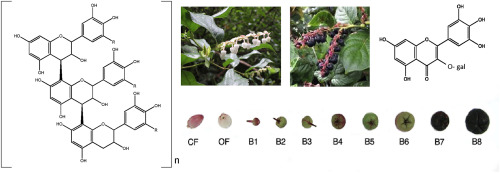当前位置:
X-MOL 学术
›
Phytochemistry
›
论文详情
Our official English website, www.x-mol.net, welcomes your feedback! (Note: you will need to create a separate account there.)
Phytochemical analysis of salal berry ( Gaultheria shallon Pursh.), a traditionally-consumed fruit from western North America with exceptionally high proanthocyanidin content
Phytochemistry ( IF 3.8 ) Pub Date : 2018-03-01 , DOI: 10.1016/j.phytochem.2018.01.002 Andrew Ferguson , Elisabete Carvalho , Geraldine Gourlay , Vincent Walker , Stefan Martens , Juha-Pekka Salminen , C. Peter Constabel
Phytochemistry ( IF 3.8 ) Pub Date : 2018-03-01 , DOI: 10.1016/j.phytochem.2018.01.002 Andrew Ferguson , Elisabete Carvalho , Geraldine Gourlay , Vincent Walker , Stefan Martens , Juha-Pekka Salminen , C. Peter Constabel

|
Salal (Gaultheria shallon Pursh.) is a wild perennial shrub of the Ericaceae and common in coastal forests of western North America, and its berries were an important traditional food for First Nations in British Columbia. Salal berries were investigated for phytochemical content and antioxidant capacity over the course of fruit development. The proanthocyanidin content was extremely high in young berries (280.7 mg/g dry wt) but dropped during development to 52.8 mg/g dry wt. By contrast, anthocyanins accumulated only at the late berry stages. Total antioxidant capacity, as measured by the 2,2'-azinobis-(3-ethylbenzothiazoline-6-sulfonic acid (ABTS) method, reflected both proanthocyanidin and anthocyanin content, and in mature berries reached 36 mmol Trolox equivalents/100 g dry wt. More detailed phytochemical analysis determined that delphinidin 3-O-galactoside is the dominant anthocyanin, and that the berries are also rich in procyanidins, including procyanidin A2 which has been implicated in anti-adhesion activity for uropathogenic E. coli. Proanthocyanidins were 60% prodelphinidin, and overall concentrations were higher than reported for many Vaccinium species including blueberry, lingonberry, and cranberry. Overall, the phenolic profile of salal berries indicates that these fruit contain a diversity of health-promoting phenolics.
中文翻译:

Salal berry ( Gaultheria semilon Pursh.) 的植物化学分析,这是一种来自北美西部的传统食用水果,原花青素含量极高
Salal (Gaultheria semilon Pursh.) 是杜鹃花科多年生野生灌木,常见于北美西部沿海森林,其浆果是不列颠哥伦比亚省原住民的重要传统食物。在果实发育过程中研究了 Salal 浆果的植物化学成分和抗氧化能力。年轻浆果中的原花青素含量极高(280.7 毫克/克干重),但在发育过程中降至 52.8 毫克/克干重。相比之下,花青素仅在浆果后期积累。通过 2,2'-azinobis-(3-ethylbenzothiazoline-6-sulfonic acid (ABTS) 方法测量的总抗氧化能力反映了原花青素和花青素含量,在成熟浆果中达到 36 mmol Trolox 当量/100 g 干重. 更详细的植物化学分析确定飞燕草素 3-O-半乳糖苷是主要的花青素,浆果还富含原花青素,包括原花青素 A2,它与尿路致病性大肠杆菌的抗粘连活性有关。原花青素为 60% 原飞燕草素,总体浓度高于许多越桔属植物(包括蓝莓、越橘和蔓越莓)的报告。总体而言,salal 浆果的酚类成分表明这些水果含有多种促进健康的酚类物质。并且总体浓度高于包括蓝莓、越橘和蔓越莓在内的许多越橘属物种的报告。总体而言,salal 浆果的酚类成分表明这些水果含有多种促进健康的酚类物质。并且总体浓度高于包括蓝莓、越橘和蔓越莓在内的许多越橘属物种的报告。总体而言,salal 浆果的酚类成分表明这些水果含有多种促进健康的酚类物质。
更新日期:2018-03-01
中文翻译:

Salal berry ( Gaultheria semilon Pursh.) 的植物化学分析,这是一种来自北美西部的传统食用水果,原花青素含量极高
Salal (Gaultheria semilon Pursh.) 是杜鹃花科多年生野生灌木,常见于北美西部沿海森林,其浆果是不列颠哥伦比亚省原住民的重要传统食物。在果实发育过程中研究了 Salal 浆果的植物化学成分和抗氧化能力。年轻浆果中的原花青素含量极高(280.7 毫克/克干重),但在发育过程中降至 52.8 毫克/克干重。相比之下,花青素仅在浆果后期积累。通过 2,2'-azinobis-(3-ethylbenzothiazoline-6-sulfonic acid (ABTS) 方法测量的总抗氧化能力反映了原花青素和花青素含量,在成熟浆果中达到 36 mmol Trolox 当量/100 g 干重. 更详细的植物化学分析确定飞燕草素 3-O-半乳糖苷是主要的花青素,浆果还富含原花青素,包括原花青素 A2,它与尿路致病性大肠杆菌的抗粘连活性有关。原花青素为 60% 原飞燕草素,总体浓度高于许多越桔属植物(包括蓝莓、越橘和蔓越莓)的报告。总体而言,salal 浆果的酚类成分表明这些水果含有多种促进健康的酚类物质。并且总体浓度高于包括蓝莓、越橘和蔓越莓在内的许多越橘属物种的报告。总体而言,salal 浆果的酚类成分表明这些水果含有多种促进健康的酚类物质。并且总体浓度高于包括蓝莓、越橘和蔓越莓在内的许多越橘属物种的报告。总体而言,salal 浆果的酚类成分表明这些水果含有多种促进健康的酚类物质。


























 京公网安备 11010802027423号
京公网安备 11010802027423号